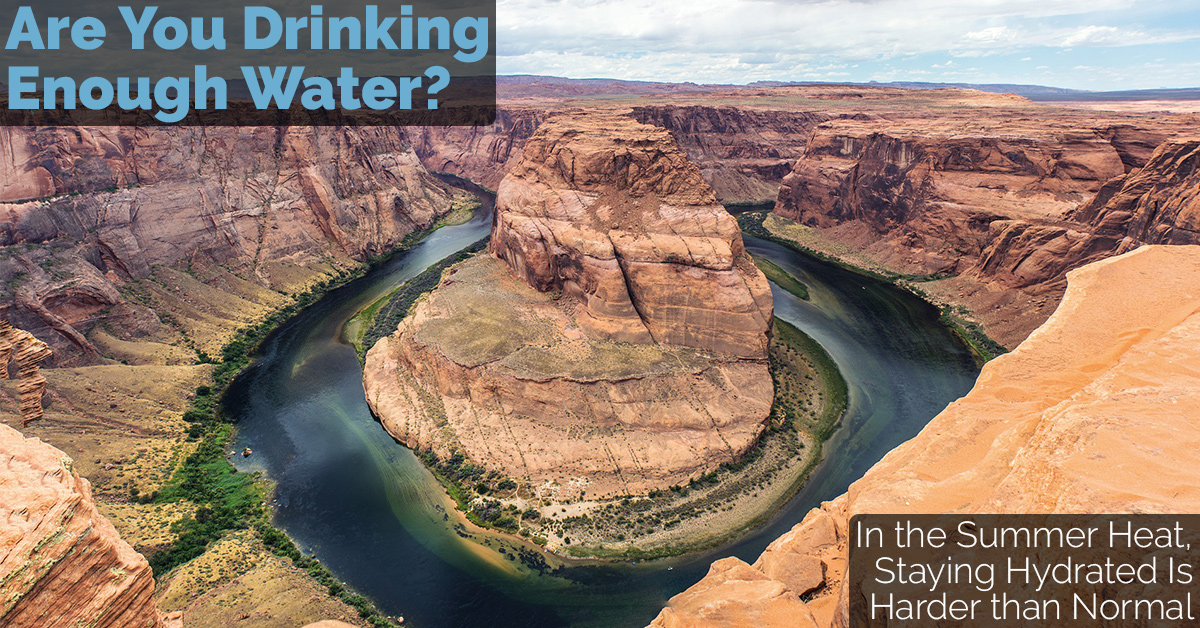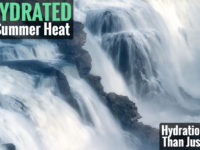It’s the hot time of the year again, at least here in the northern hemisphere. I mean, it’s been incredibly hot for over a month now, but mid-July through August is traditionally the hottest part of the year where I live in Boulder, CO, so since we’ve already had a few days flirting with 100° Fahrenheit (38° Celsius), it’s probable we’ll get at least a few breaking above it.
Now, hopefully if you’re climbing, you’re someplace cooler—but unless you’re travelling far (or already live there), that “cooler” is going to be relative to an overall hot day. Air temps will still be high, even if you’re sheltered from the direct heat of the sun. And hot air temps lead to increased core temps and increased sweating, just as solar radiation does. That means higher rates of fluid loss, and increased need for fluid intake. The question is, are you getting enough fluid to make up for those losses?
How Much Fluid Do You Lose in a Day?
For the type of climbing situation we’re going to talk about here, this is a complicated question to answer. If you’re climbing in the gym, or going for an hour long afternoon run, then the calculation is not complicated as it basically involves weighing yourself both before and after you exercise, finding the difference, and subtracting out the fluid you consumed while exercising. For outdoor climbing—frequently an all-day or at least half-day endeavor—there are so many complicating factors that it becomes hard (if not practically impossible) to actually measure.
For example, while climbing outdoors, you’re probably bringing and consuming food. You’ll relieve yourself a few times, most likely, and probably won’t bring a scale to weigh yourself afterwards (or a measuring cup, haha). Furthermore, your rate of sweat will be variable depending on the temperature (which will increase over time), your level of continuous exertion (which is probably during the hike in), and the humidity (which will often decrease over time).
You can measure your sweat rate in the gym as a proxy, but it’ll only be partially accurate because gyms usually have decent climate control, even if we all complain that they’re too stingy with their air conditioning. It’s unlikely your gym ever gets hotter than around 76-78° Fahrenheit (25° Celsius), and unless you’re at some swanky outdoor gym, you’ll never experience the additional heat of the sun beating upon you. Measuring at a gym, then, can give you a projected minimum rate of fluid loss, but you should assume you’ll lose more fluids outdoors—potentially considerably more.
In earlier articles, I’ve stated that athletes typically lose around 1 liter of sweat per hour in normal exercise conditions. This is a standard reference number, but it’s also very dependent on how “average” you are and how “normal” the exercise conditions are. If we look at low-intensity indoor exercise meant to simulate outdoor manual labor, we see sweat rates of 0.2 to 0.8 liters per hour, with most people sweating 0.4 to 0.5 liters per hour (they were inside a heat chamber, though, not in the sun, so actual rates would likely be higher). In (American) football players, sweat rates varied from 1.4 to 2.25 liters with an average of 1.84 liters per hour. For cross-country runners, the average rate was 1.56 liters per hour in the morning and 1.97 liters per hour in the afternoon.
For climbers, the numbers will of course be different, as they will be on an individual level anyway and then also further depend on the conditions. But, it should be clear that athletes exercising—especially during hotter times of the year—should assume they are sweating at least 0.75 liters per hour and most likely more than a liter. Some are certainly losing 2 liters an hour, or roughly a gallon of sweat every two hours.
You Need to Replace Your Lost Fluids
Dehydration harms performance, particularly when exercise goes long. There’s been a recent rise in the “drink to thirst” mentality in sport, driven by a number of studies that have shown that mild dehydration doesn’t harm short-term performance (such as this one), but there are limitations to using thirst as a guide, especially when exercise will extend for greater than three hours.
The biggest issue is that short-term exercise will never cause major dehydration when a person drinks to thirst. There simply isn’t enough time to create the amount of fluid loss a person cannot easily recover from in the period after exercise. With increasing time, however, the ability to become dehydrated in a performance-effecting manner also increases. During exercise thirst sensation is often diminished, and drinking to thirst does not adequately replenish fluids when exercise is extended.
There are also a plethora of reasons for why your own sensation of thirst may be compromised or misleading. For example, if you bring only two liters of water to a crag for a half-day session, you’ll probably choose to ration the water and not drink it all within the first couple hours. You may realize this was a mistake as your thirst grows, or you may downplay your reaction to thirst and subconsciously decide it feels “normal”, saving your conscious self the pain of realizing you made an error. Regardless, when you’re out at a remote crag, water access is rarely truly “ad libitum”—there’s always the limit of how much you and your crew actually brought.
For these reasons, it’s wise to plan how much water you intend to drink and then bring at least that much with you. This may mean a few gallons, and yes, that adds a lot of weight—but it also beats dehydration (plus, you’re not hauling that much up the rock; in most cases you’re hauling none). Based on the averages I listed above, you should bring at least one liter of water per hour of exercise, but bringing two liters for each hour is probably wiser.
Or, you can save weight and just bring a water filter if you’re going to be in an area with water. Water filters are lightweight, easily packable, and make ad libitum water intake actually possible since you can filter however much you need. With a water filter, you’re probably safe carrying only a liter or two at a time (depending on the area and conditions, of course).
It’s Hot—Stay Hydrated
In a recent episode of ClimbSci, Tom and I briefly discuss hydration. Tom’s from the UK, where temperatures are much milder on average than here, so he worried far less about dehydration than I do; there’s definitely a regional bias at play here, for both of us! What I know is what I witness, and I constantly witness (and overhear conversations) poor hydration planning.
I get it, the same as I get why I see so many climbers bring inadequate amounts of food up to a crag. Water and food have weight, and when you’re already required to carry so much weight in the form of gear you start to cut weight that seems inessential. Cutting that weight does take its toll in terms of performance, though, and I don’t recommend it.
When it’s hot (and when it’s not, for that matter), make sure you’re bringing enough water to stay hydrated. Even if you don’t end up using all of it, it’s better to have it—accidents and emergencies do happen, and you’ll be far happier to have the water when you really need it than upset that you brought too much.







